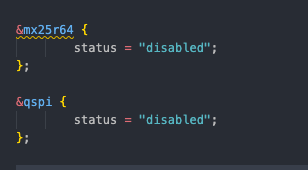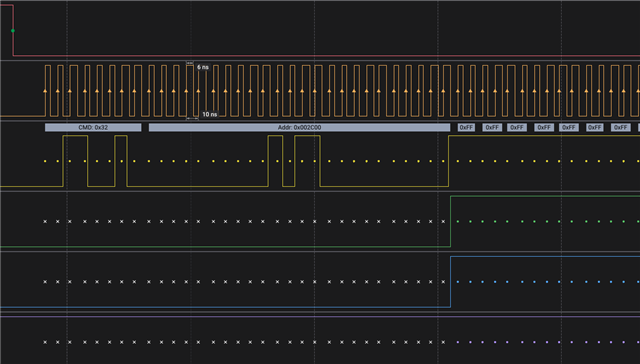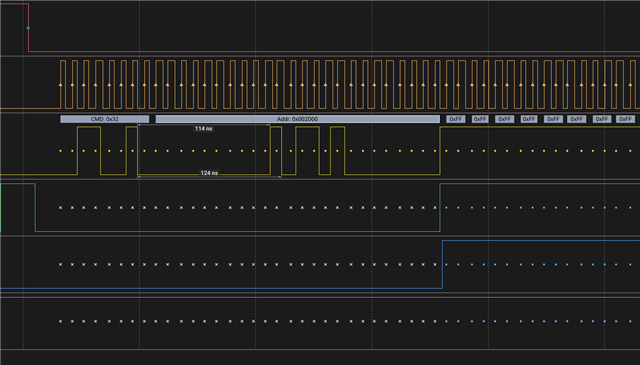*EDIT* - Using NCS 2.9
I am using the QSPI peripheral to communicate with a display.
1. I initialize the QSPI peripheral. I have tried both blocking and non-blocking. Both return successfully.
//ret = nrfx_qspi_init(&config, NULL, NULL);
ret = nrfx_qspi_init(&config, nrfx_qspi_handler, NULL);
if (ret != NRFX_SUCCESS)
{
LOG_ERR("Error writing to QSPI");
}
2.) I attempt to read or write to the QSPI peripheral.
- I get two different errors.
Blocking Mode - this gives me the "NRFX_TIMEOUT" error.
Non-Blocking Mode - No error
A logic analyzer shows both methods continuously transmitting data. It does not just transmit/read the specified number of bytes.
I have made sure my buffers are word aligned.
uint8_t read_data[16] = {0};
ret = nrfx_qspi_read(read_data, 16, LCD_SET_REG_ADDRESS(0x81));
if (ret != NRFX_SUCCESS)
{
LOG_ERR("Error reading from QSPI %s", nrfx_error_string_get(ret));
}
LOG_HEXDUMP_INF(read_data, 16, "Read data");
k_sleep(K_MSEC(100));
is_tx_done = false;
uint32_t address = 0x80 << 8;
uint8_t cmd[4] = {0}; //__attribute__((aligned(4)))
cmd[0] = 0x1;
ret = nrfx_qspi_write(cmd, sizeof(cmd), address);
if (ret != NRFX_SUCCESS)
{
LOG_ERR("Error writing to QSPI, err = %s", nrfx_error_string_get(ret));
}

3.) Overlay - I have tried disabling the QSPI or the flash for the nrf5340dk overlay. Neither of these changes the behavior.

4.) Clock - I must call nrf_clock_hfclk192m_div_set(NRF_CLOCK, NRF_CLOCK_HFCLK_DIV_1) before reading or writing or I get an NRFX_ERROR_FORBIDDEN error.
This is due to the NRF53_ERRATA_159_ENABLE_WORKAROUND below.
if (qspi_errata_159_conditions_check())
{
return NRFX_ERROR_FORBIDDEN;
}
static bool qspi_errata_159_conditions_check(void)
{
#if NRF_CLOCK_HAS_HFCLK192M && NRF53_ERRATA_159_ENABLE_WORKAROUND
if ((nrf_clock_hfclk192m_div_get(NRF_CLOCK) != NRF_CLOCK_HFCLK_DIV_1) ||
(nrf_clock_hfclk_div_get(NRF_CLOCK) != NRF_CLOCK_HFCLK_DIV_2))
{
return true;
}
else
#endif
{
return false;
}
}
I have tried disabling this workaround in may CMakeFile.txt with target_compile_definitions(app PRIVATE NRF53_ERRATA_159_ENABLE_WORKAROUND=0), however, this does not seem to work. Is there a correct way to disable this workaround?
I would like to run from a 128Mhz HFCLK, but this seems to cause issues.
5. Prj - Here are my PRJ file configs. I have attempted to disable QSPI NOR features.
CONFIG_NRFX_QSPI=y
CONFIG_SPI_NOR=n
CONFIG_NORDIC_QSPI_NOR=n # Enable SPI NOR flash support
CONFIG_PINCTRL=y
Any ideas on a solution to allow the QSPI peripheral to function correctly? I am concerned the NRFX QPSI is conflicting with the device tree QSPI settings. Or perhaps I am missing critical configuration settings for the QSPI peripheral to allow it to read and write.





